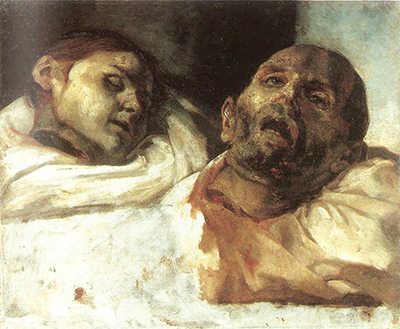Géricault caused a stir with his memorial work The Raft of Medusa, in the Paris Salon of 1819. The painting depicts the dead who die and survive after the crash of the French off the coast of Africa. This tragedy and the treatment of the government caused a political disgrace in France.
In drawing up of the portrait, Gericault conducted many studies on corpses and body parts, including Severed Heads. The creepy realism in this portrait marks a departure from earlier ideas and a renewed interest in more dramatic themes. The practicality of Géricault's research of the severed heads is almost intolerable. The painter painted a series of similar pictures, sometimes with arms and legs amputated. There is probably a connection with his work of art The Raft of Medusa (Louvre), which displays the dying victims of wreckage. These images can be considered as approaches to death, with the eventual goal of making it as convincing as possible.
Description and analysis of artworks: Guillotine heads by Gericault's show a cruel description of decay and death. On the left side is the female head which has closed eyes and bright white skin, while on the right is the male head with open mouth and open eyes which look at the viewer freely. Serrated, rough spots on the neck illustrate the cruel and torturous death these characters have agonized at the guillotine. In this portrait, Gericault illustrates his brilliant mastery of the light-dark technique, which is reflected in the contrasts of darkness and light all over the composition. Loose lines for the visualization of face and tissue contribute to the dramatic effect of the work.
Cut limbs and body parts are the main themes in the work of Gericault. The five artworks he made in this style are regarded as studies of the information that he showed in his most well-known work, (1818-1819) The Raft of Medusa. The artist, who always strives for authenticity, has received body parts of the sufferers of the severed heads in his studio. Gériault's use of terrible objects was first and foremost an imaginative means to cross borders, but also a means of political communication. The vivid, direct and confrontational image of the severed heads is not visually suited to the barbaric form of penalty that was customary in the restoration of the Bourbons. The painting of the severed heads is an oil on canvas that is found in Stockholm in Sweden, at the National Museum.




